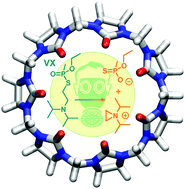Influence of cyclic and acyclic cucurbiturils on the degradation pathways of the chemical warfare agent VX†
Abstract
The highly toxic nerve agent VX is a methylphosphonothioate that degrades via three pathways in aqueous solution, namely through the hydrolysis of the P–O or P–S bonds, or the cleavage of the C–S bond at the 2-aminoethyl residue. In the latter case, an aziridinium ion and a phosphonothioate is formed. Here it is shown that acyclic or cyclic cucurbiturils inhibit these reactions in phosphate buffer at physiological pH and thus stabilise the nerve agent. When using unbuffered basic solutions as the reaction medium, however, in which the P–S or P–O bonds are normally hydrolysed preferentially, cucurbiturils turned out to strongly shift VX degradation towards the cleavage of the C–S bond. Cucurbit[7]uril, in particular, has a so pronounced effect under suitable conditions that it almost completely suppresses the formation of products resulting from the other degradation pathways. Investigations involving VX analogues in combination with computational methods suggest that one reason for the reaction control exerted by the cucurbiturils is the preorganisation of VX for aziridinium ion formation. In addition, cucurbit[7]uril also lowers the transition state of the reaction by stabilising the positive charge developing on the way to the product. Cucurbiturils thus have a marked effect on the reactivity of a highly toxic nerve agent, which potentially allows using them for decontamination purposes.

- This article is part of the themed collection: Supramolecular chemistry in OBC


 Please wait while we load your content...
Please wait while we load your content...